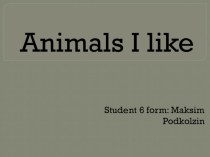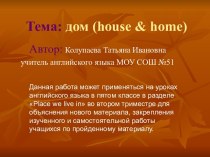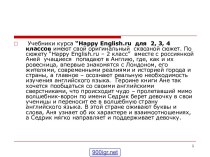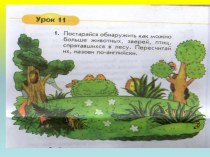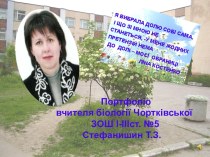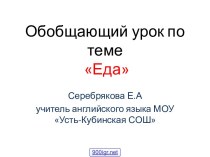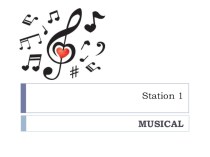- Главная
- Разное
- Бизнес и предпринимательство
- Образование
- Развлечения
- Государство
- Спорт
- Графика
- Культурология
- Еда и кулинария
- Лингвистика
- Религиоведение
- Черчение
- Физкультура
- ИЗО
- Психология
- Социология
- Английский язык
- Астрономия
- Алгебра
- Биология
- География
- Геометрия
- Детские презентации
- Информатика
- История
- Литература
- Маркетинг
- Математика
- Медицина
- Менеджмент
- Музыка
- МХК
- Немецкий язык
- ОБЖ
- Обществознание
- Окружающий мир
- Педагогика
- Русский язык
- Технология
- Физика
- Философия
- Химия
- Шаблоны, картинки для презентаций
- Экология
- Экономика
- Юриспруденция
Что такое findslide.org?
FindSlide.org - это сайт презентаций, докладов, шаблонов в формате PowerPoint.
Обратная связь
Email: Нажмите что бы посмотреть
Презентация на тему The Phonological Analysis of English Speech Sounds
Содержание
- 2. The Phonological Analysis of English Speech SoundsSpeech
- 3. The Phonological Analysis of English Speech SoundsIn
- 4. The phoneme, its definition, aspects and functions/pil/
- 5. The Phonological Analysis of English Speech Soundspill
- 6. The phoneme, its definition, aspects and functionsThat’s
- 7. The phoneme, its definition, aspects and functionsAll
- 8. The phoneme, its definition, aspects and functionsV.A.
- 9. The phoneme, its definition, aspects and functionsThe aspects of the phoneme:material, real and objectiveabstractional and generalisedfunctional
- 10. The phoneme, its definition, aspects and functions
- 11. The phoneme, its definition, aspects and functions
- 12. The phoneme, its definition, aspects and functions
- 13. The phoneme, its definition, aspects and functionsThe
- 14. The phoneme, its definition, aspects and functionsThe
- 15. The phoneme, its definition, aspects and functionsThe
- 16. The phoneme theoryThe phoneme theory was originated
- 17. The phoneme theoryBaudouin de Courtenay Ivan Alexandrovich
- 18. The phoneme theoryBaudouin de Courtenay supported the
- 19. The phoneme theoryLev Vladimirovich Shcherba (commonly Scherba)
- 20. The phoneme theory. Shcherba.L.V. Shcherba developed Baudouin
- 21. The phoneme theory . ShcherbaSuch types are
- 22. The phoneme theoryDaniel Jones (1881 –1967) a
- 23. The phoneme theory. Daniel Jones Daniel
- 24. The phoneme theory. Daniel Jones The
- 25. The phoneme theoryFerdinand de Saussure [sɔ:ˈsʊər], [soʊˈsʊər](1857
- 26. The phoneme theory. Ferdinand de Saussure
- 27. The phoneme theoryTrubetzkoyNikolai Sergeyevich(1890 - 1938) a
- 28. The phoneme theory. Trubetzkoy N. Trubetskoy expressed
- 29. N. Trubetskoy’s viewsPhoneme – a unity of
- 30. The phoneme theoryLeonard Bloomfield (1887 –1949) an
- 31. The phoneme theoryEdward Sapir (1884 –1939) a
- 32. The phoneme theory. StructuralistsThe American structuralists Leonard
- 33. The phoneme theoryThe functional view of the
- 34. Methods of phonological analysisDistributional method is based
- 35. Methods of phonological analysis Semantic method is
- 36. Methods of phonological analysis/si:z/ - /si:t/ /z/
- 37. Methods of phonological analysisMinimal pairs – the
- 38. Methods of phonological analysisIf two speech sounds
- 39. Methods of phonological analysis/t∫/ - /dʒ/ eat
- 40. Methods of phonological analysisThe rules to determine
- 41. Methods of phonological analysisThese rules helped to
- 42. Methods of phonological analysisThe phonemic status of
- 43. Modifications of phonemes in speech Variation idiolectal
- 44. Modifications of phonemes in speechIdiolectal variation embraces
- 45. Modifications of phonemes in speechDiaphonic variation is
- 46. Modifications of phonemes in speechAllophonic variation is
- 47. Modifications of phonemes in speechReduction – the
- 48. Modifications of phonemes in speechIn qualitative reduction
- 49. Modifications of phonemes in speechElision – the
- 50. Modifications of phonemes in speechHistorical elision reflects
- 51. Modifications of phonemes in speechAssimilation – the
- 52. Modifications of phonemes in speechAssimilation may influence:the
- 53. Modifications of phonemes in speechVoice assimilation is
- 54. Modifications of phonemes in speechThe active organ
- 55. Modifications of phonemes in speechAssimilation(according to direction)progressive
- 56. Modifications of phonemes in speechAccommodation (adaptation) –
- 57. Modifications of phonemes in speech The causes
- 58. Sound interchangeSound interchange (alternation of sounds)/k –
- 59. Sound interchangeCauses of sound interchangeSynchronic phonetic
- 60. Sound interchangeVowel alternations are used:1) To form
- 61. Sound interchangeConsonant alternations are used:1) To distinguish
- 62. IPA International Phonetic Alphabet represents each sound of human speech with a single symbol
- 63. Types of transcriptionTranscription is a visual system
- 64. Types of transcriptionPhonemic transcription shows only functional
- 65. Types of transcriptionPhonetic transcription provides a special
- 66. Types of transcription. Diacritic MarksDiacritic Marks -
- 67. Types of transcription. Diacritic Marks~ - nasalized:
- 68. Скачать презентацию
- 69. Похожие презентации
The Phonological Analysis of English Speech SoundsSpeech sounds are studied both by phonetics and phonology, but phonetics studies them as articulatory and acoustic units whereas phonology studies them as functional units which serve people for communicative
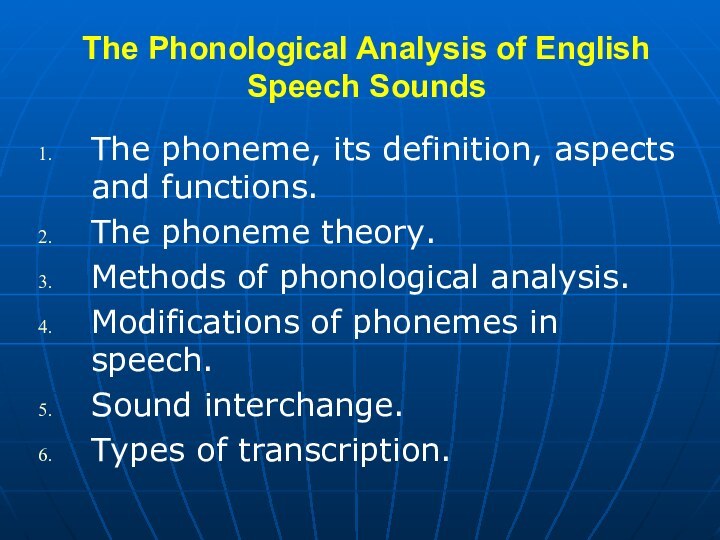

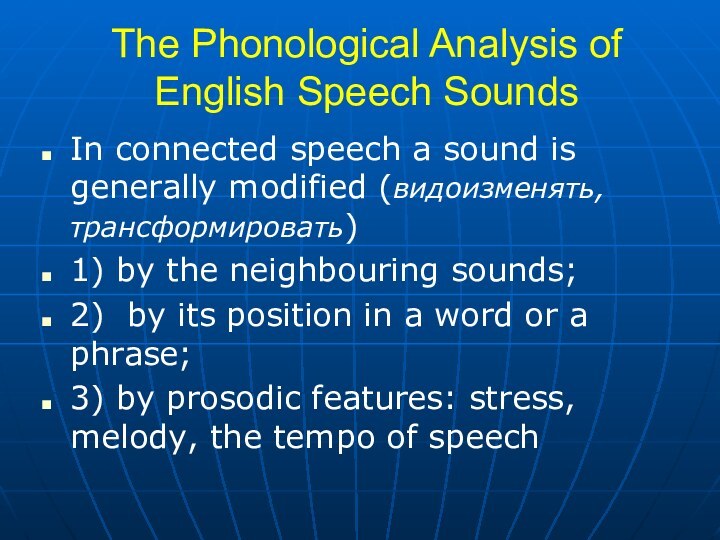
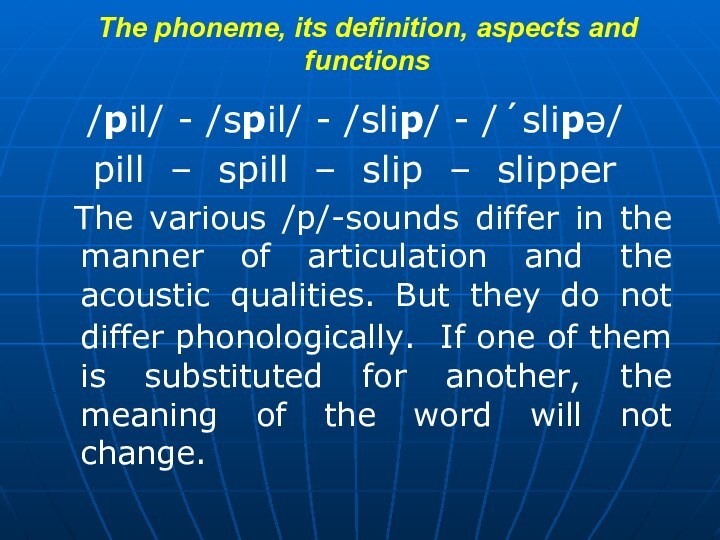
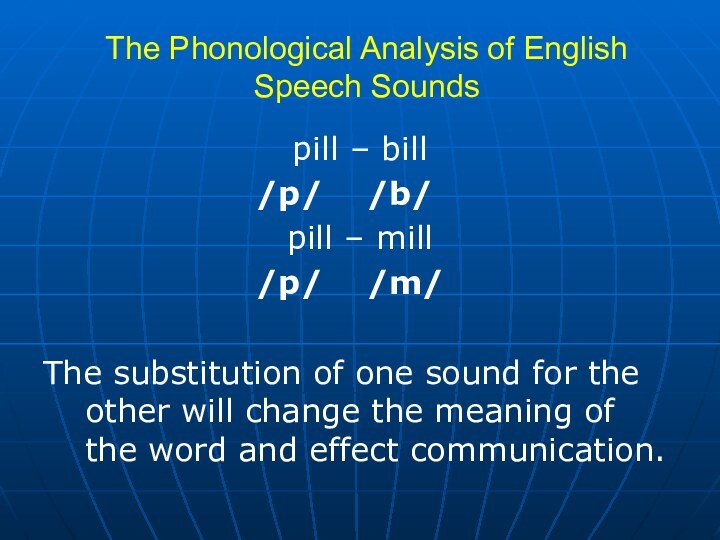

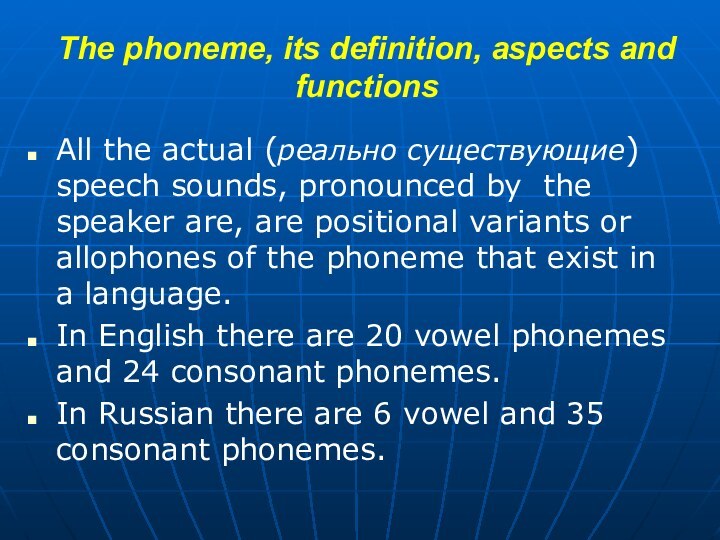
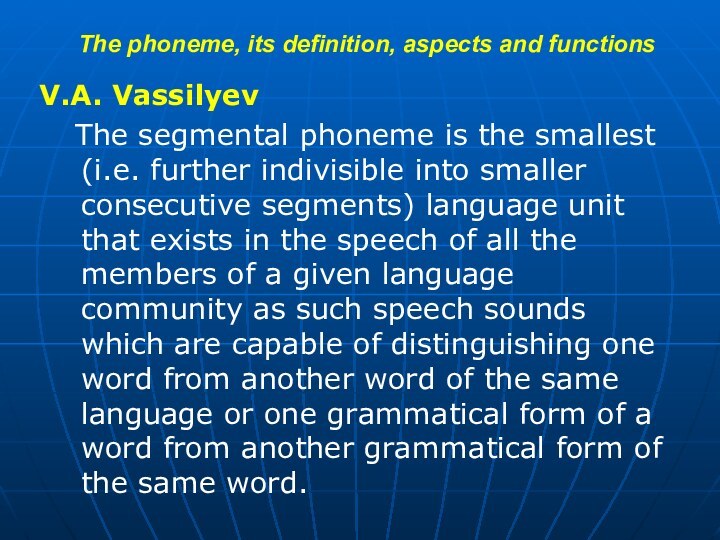
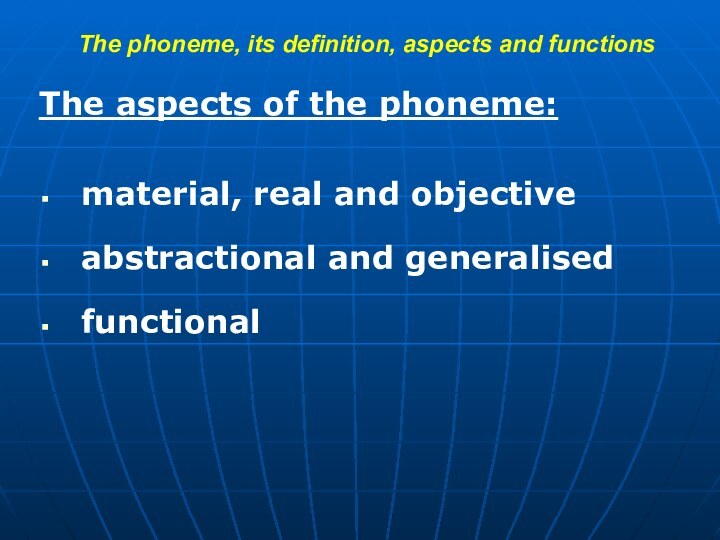
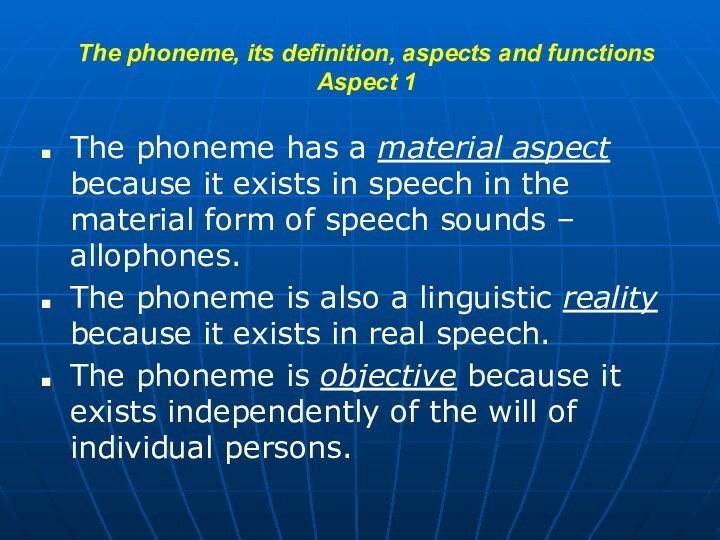

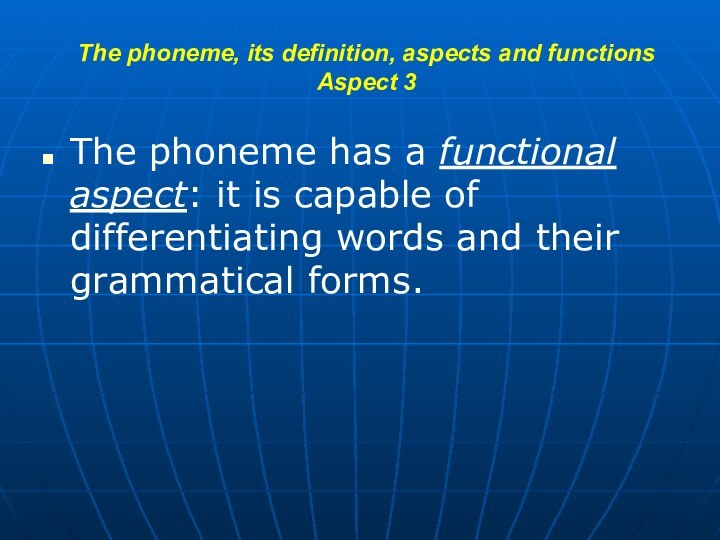
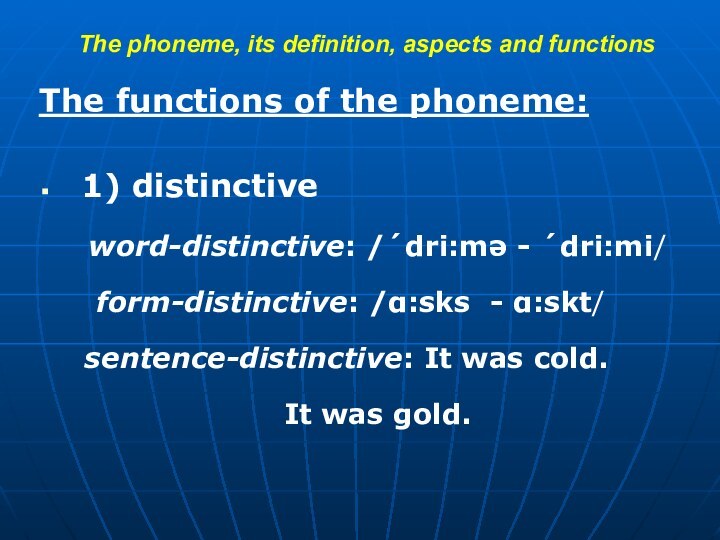


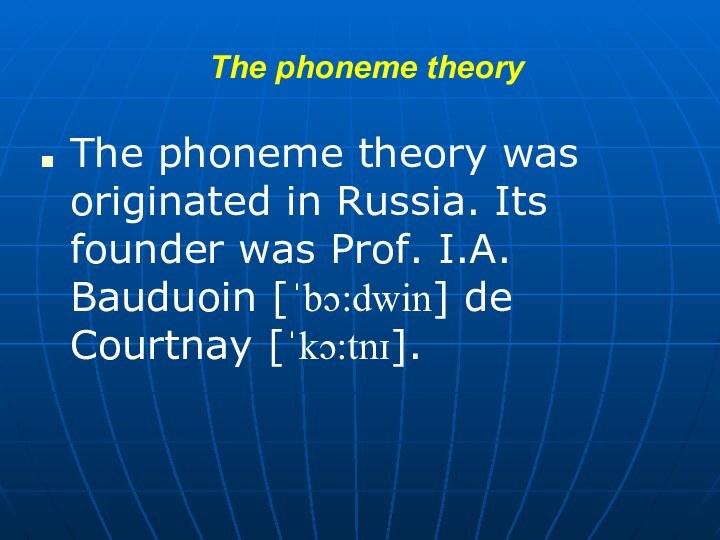
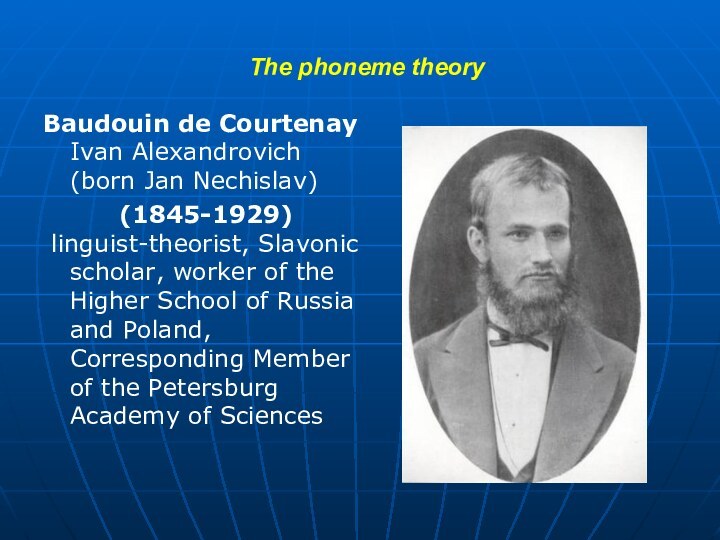
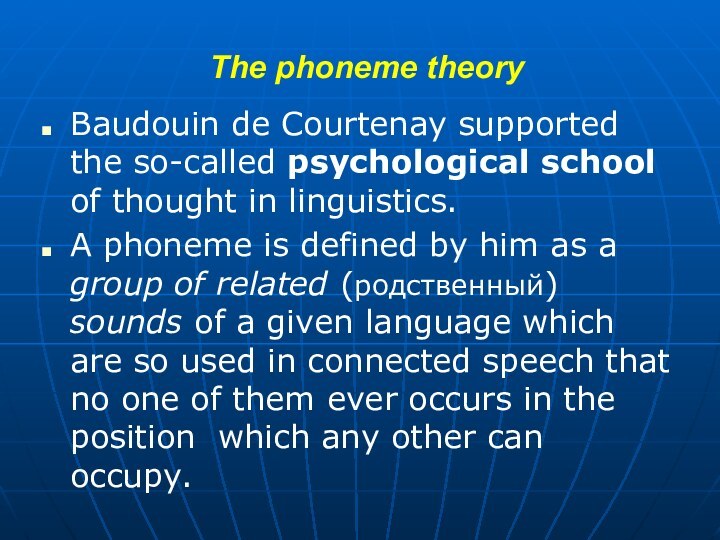
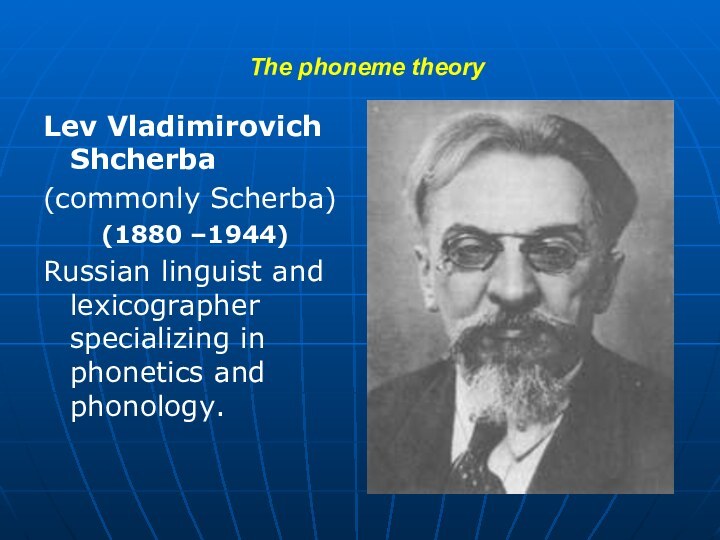
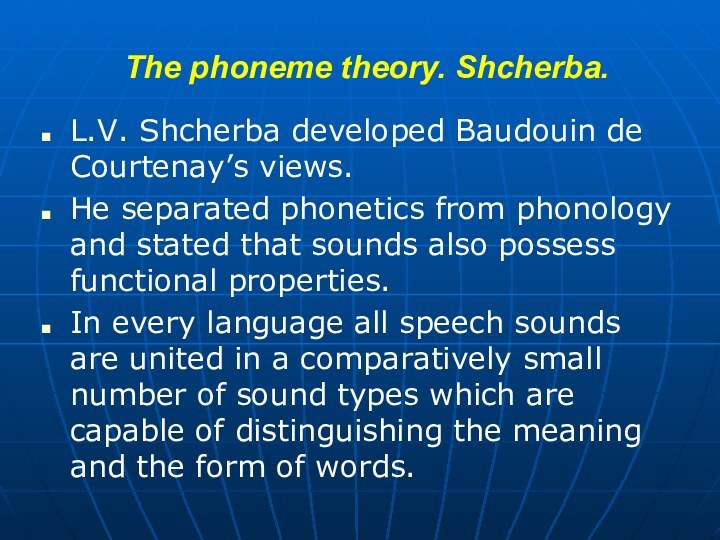
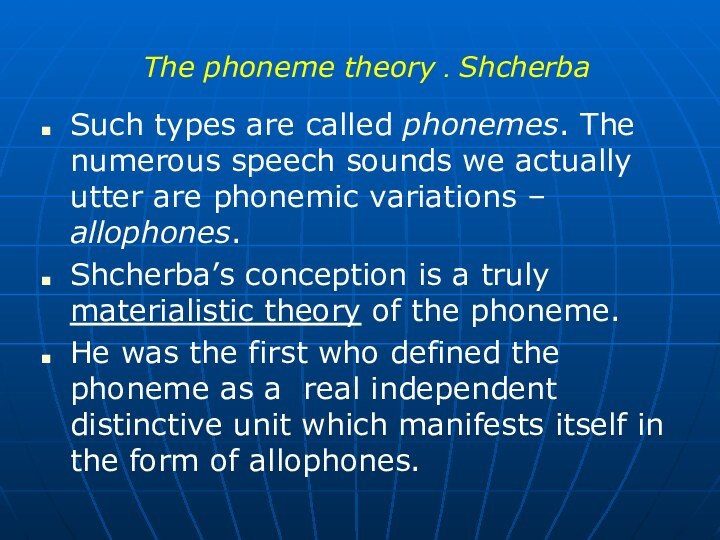
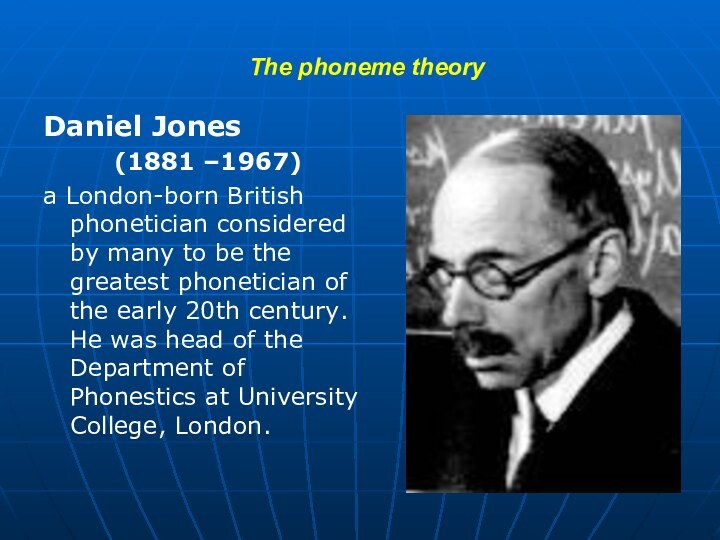
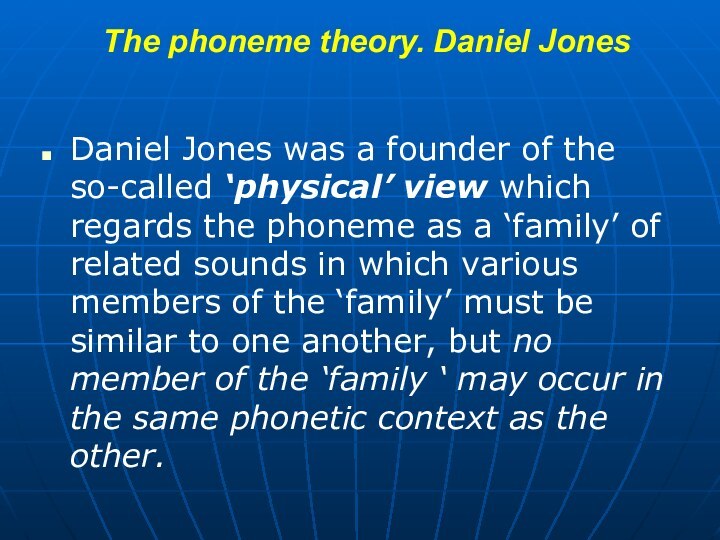
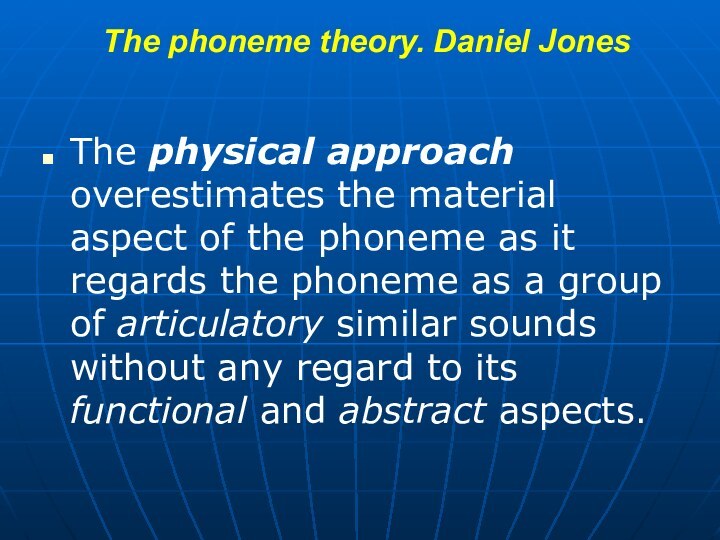
![The Phonological Analysis of English Speech Sounds The phoneme theoryFerdinand de Saussure [sɔ:ˈsʊər], [soʊˈsʊər](1857 –1913) a Swiss linguist whose](/img/tmb/15/1443545/c30d116eab7921aa679a25ba813c3bb6-720x.jpg)
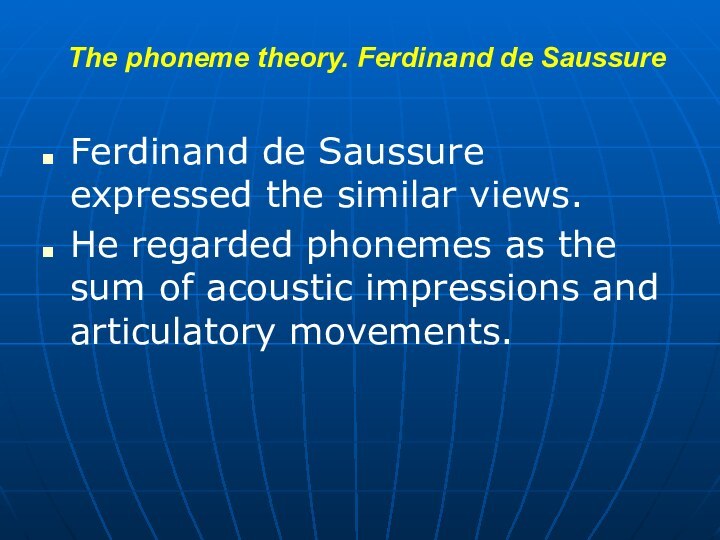

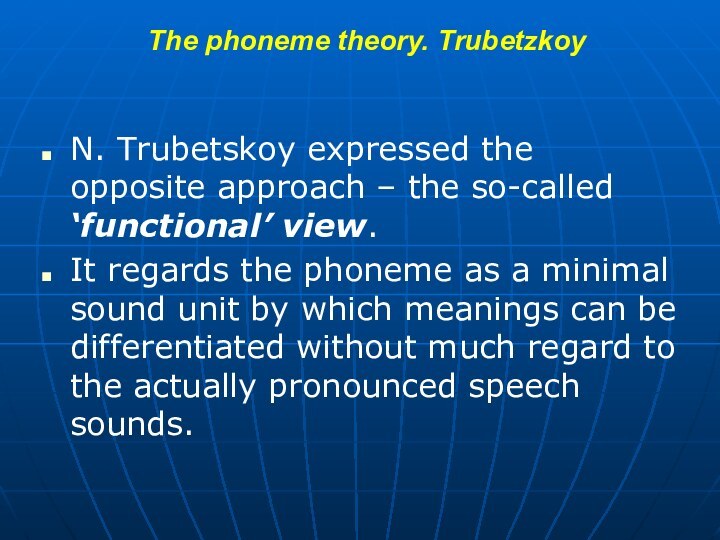
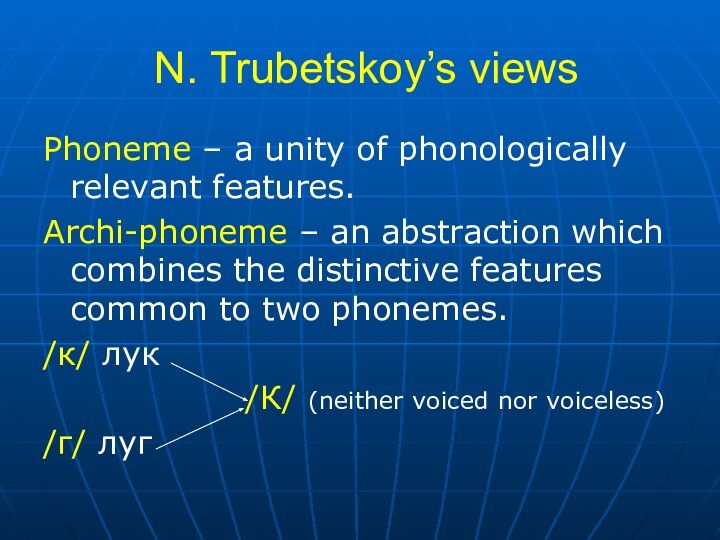


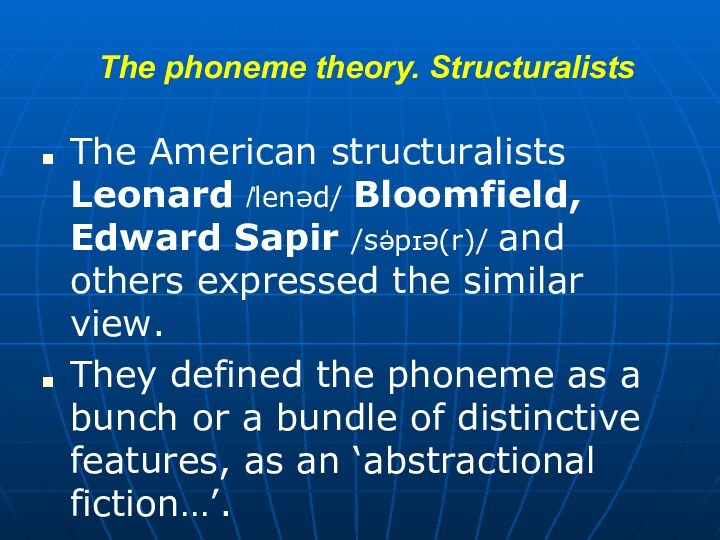
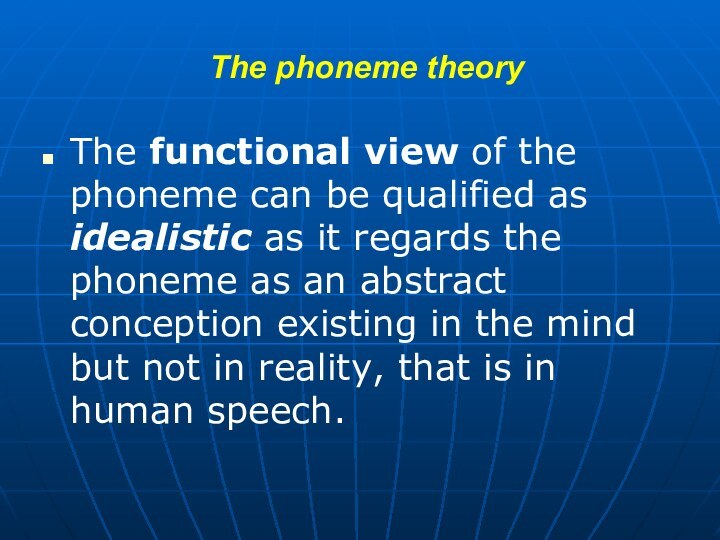
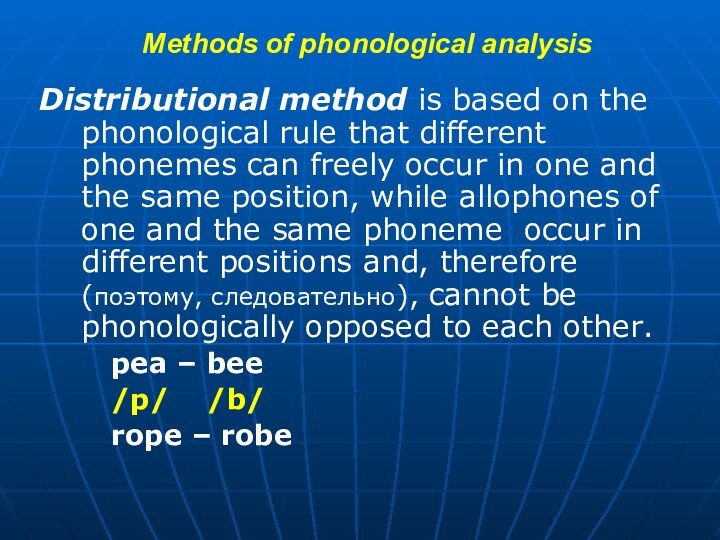
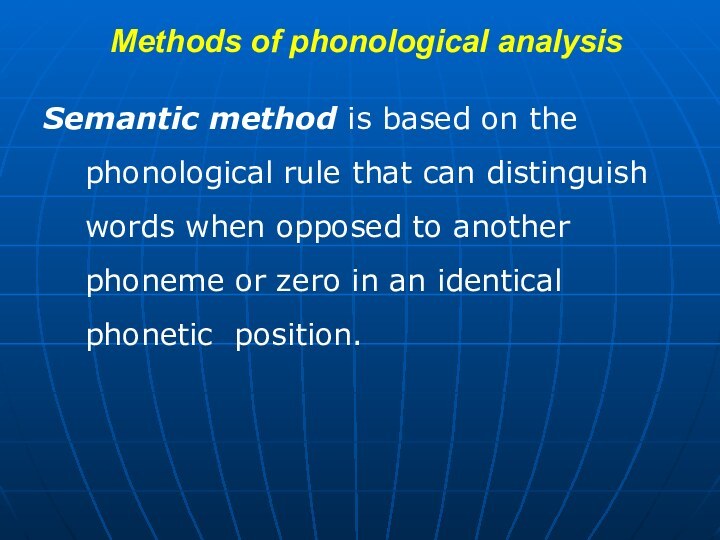


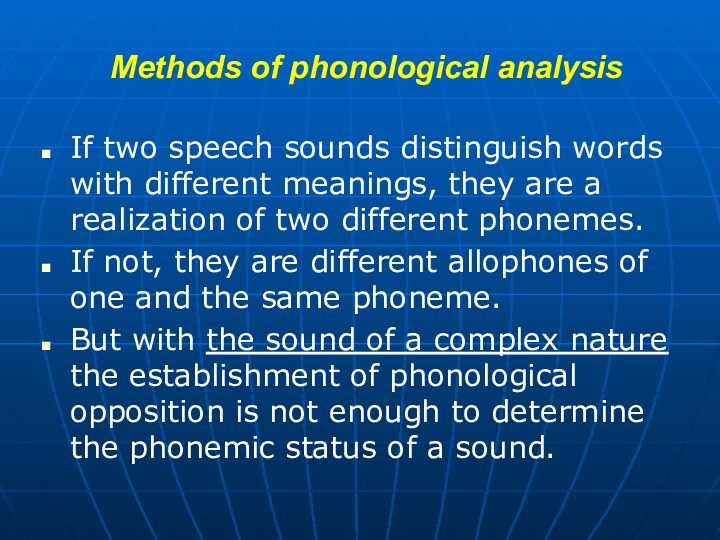


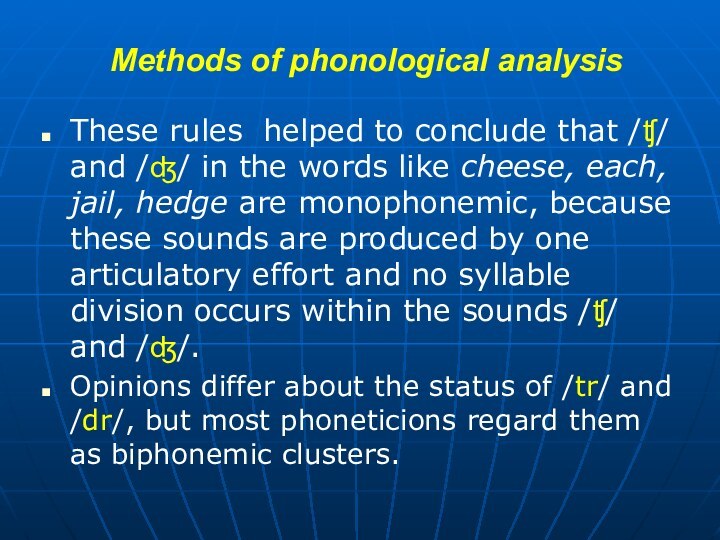
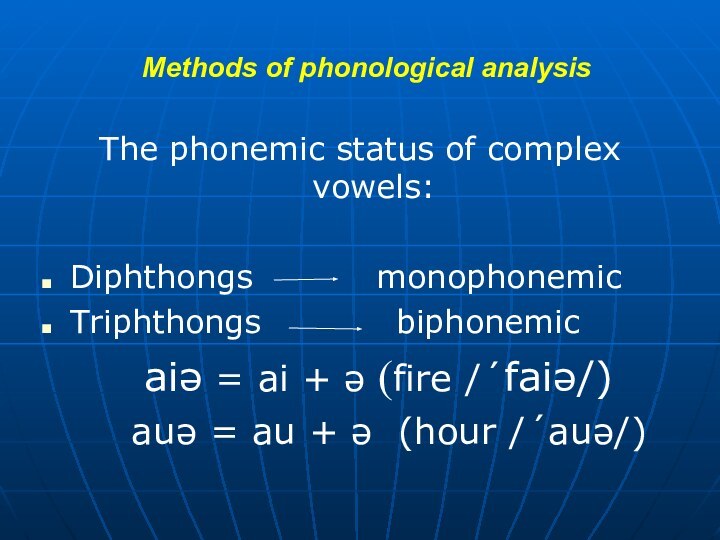
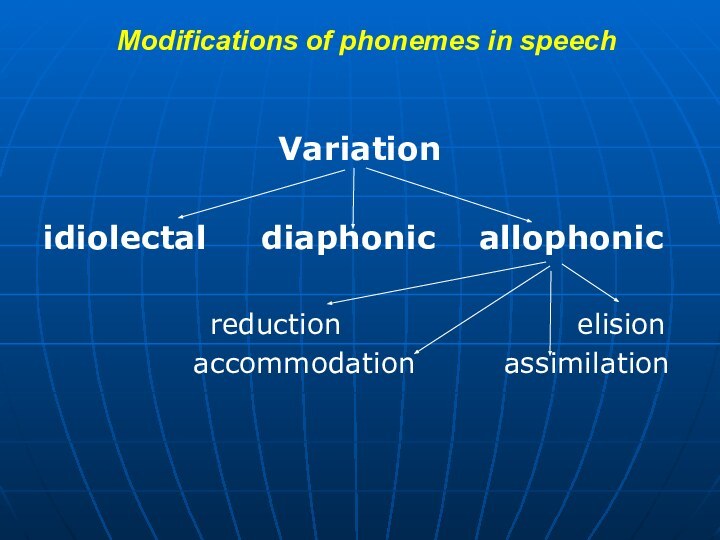
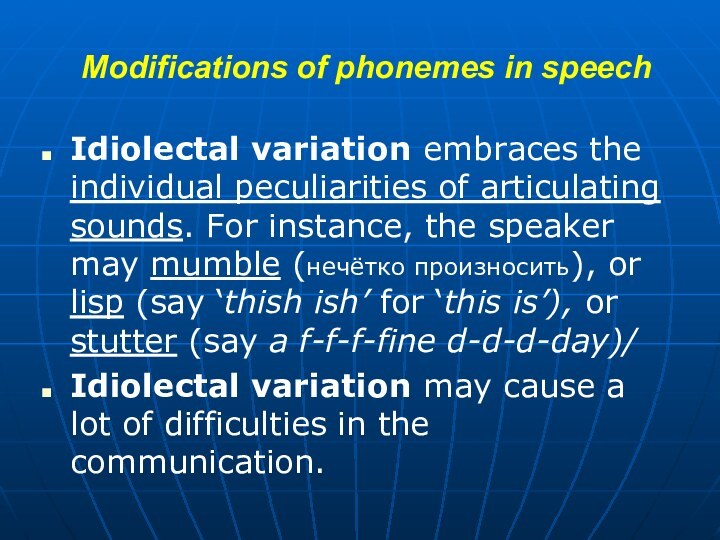
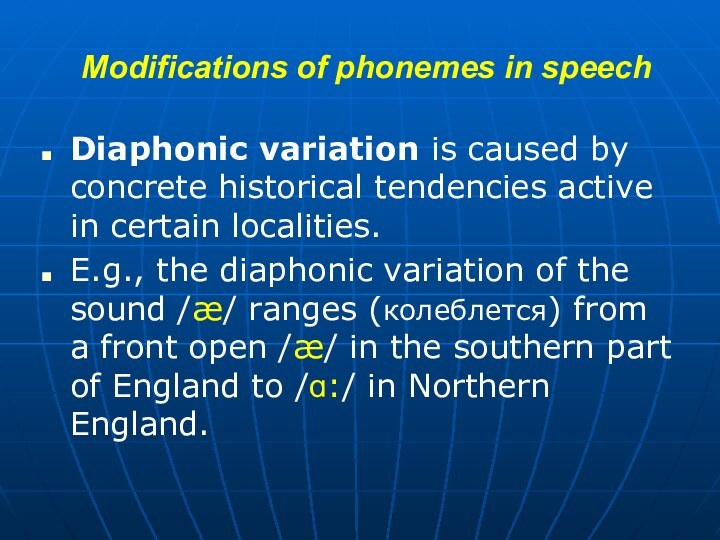

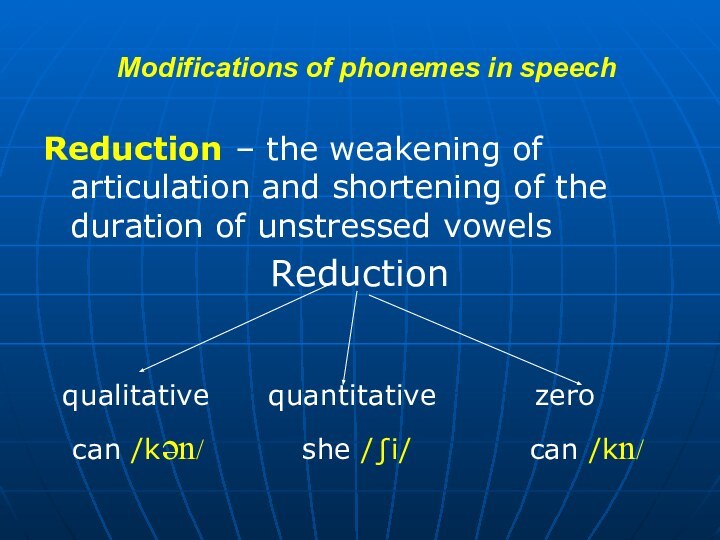

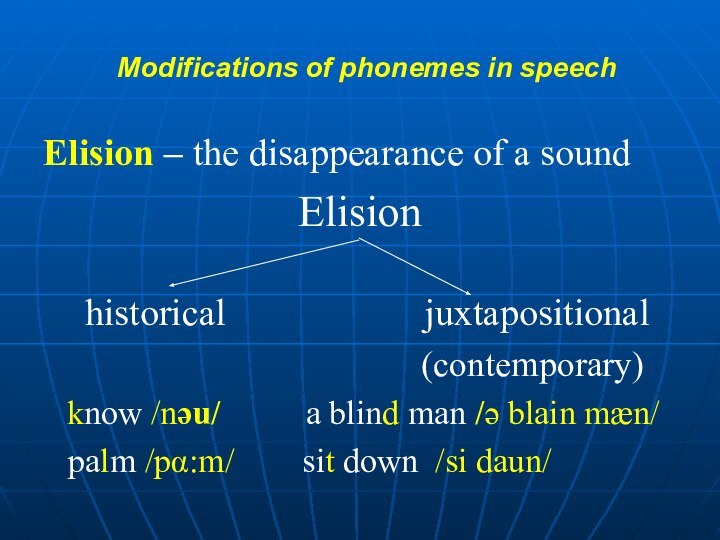
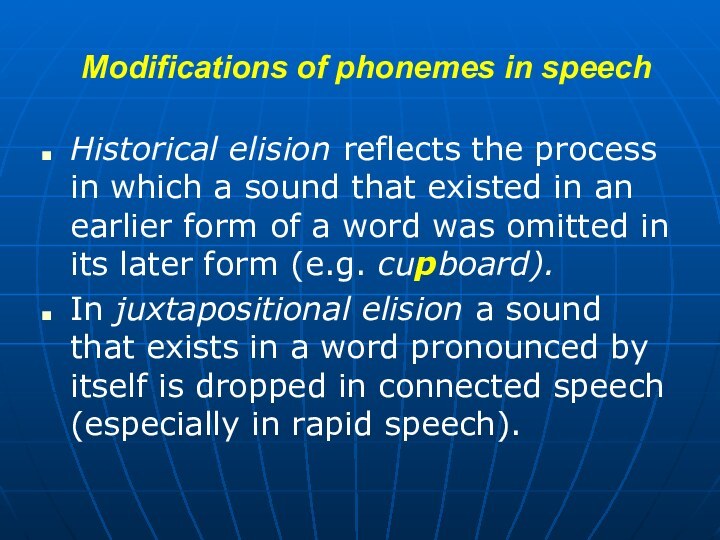

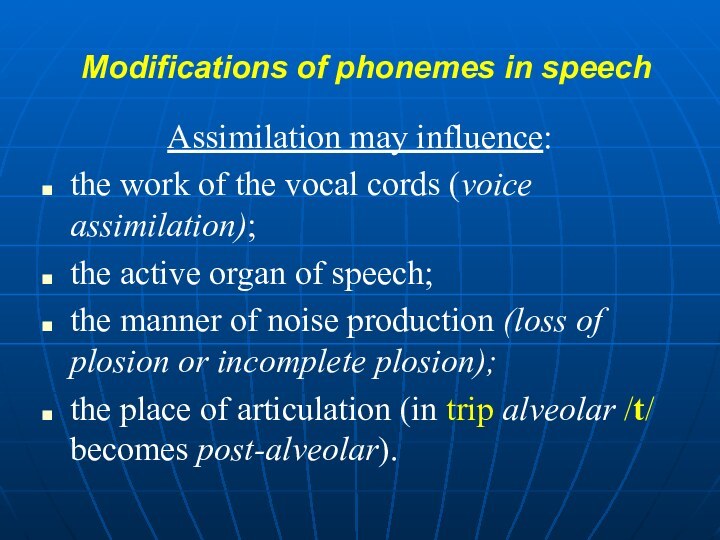

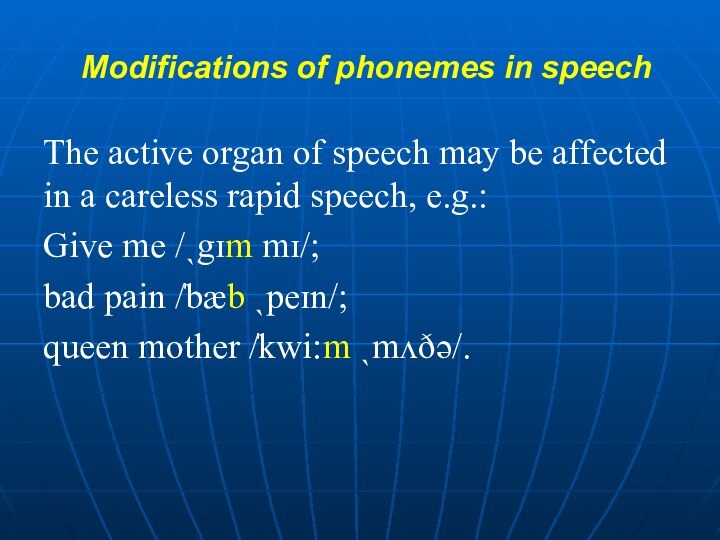
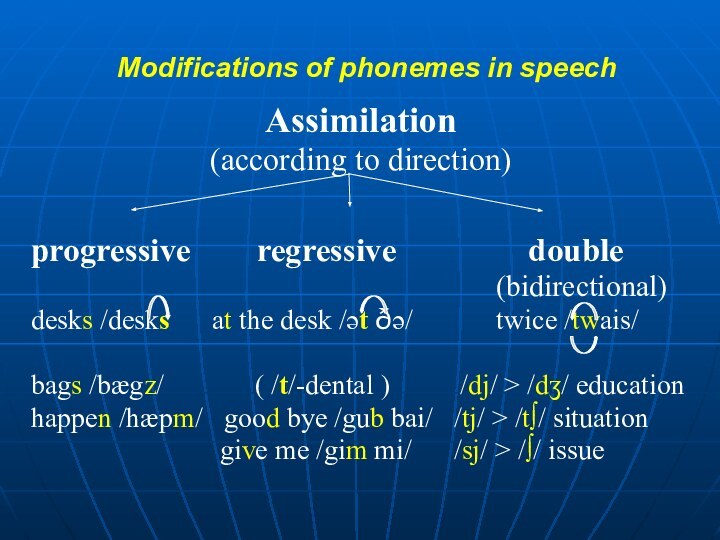
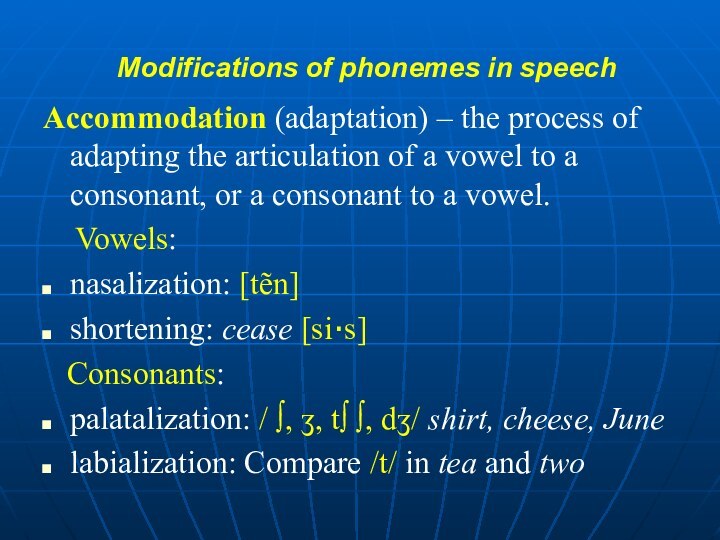
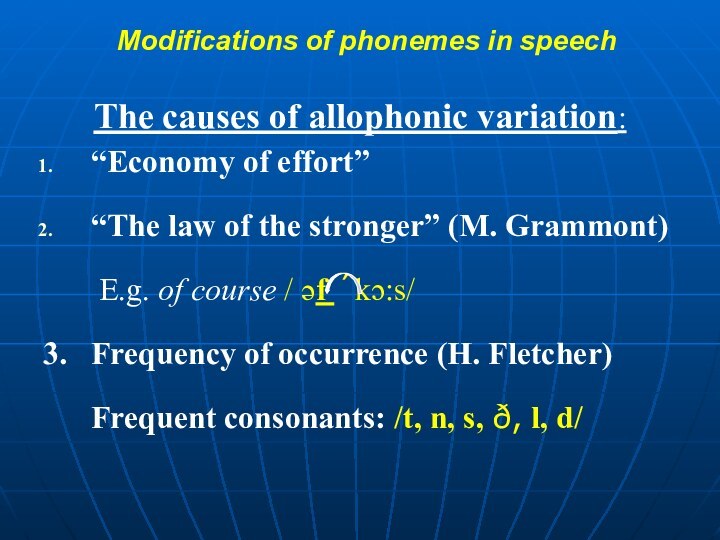
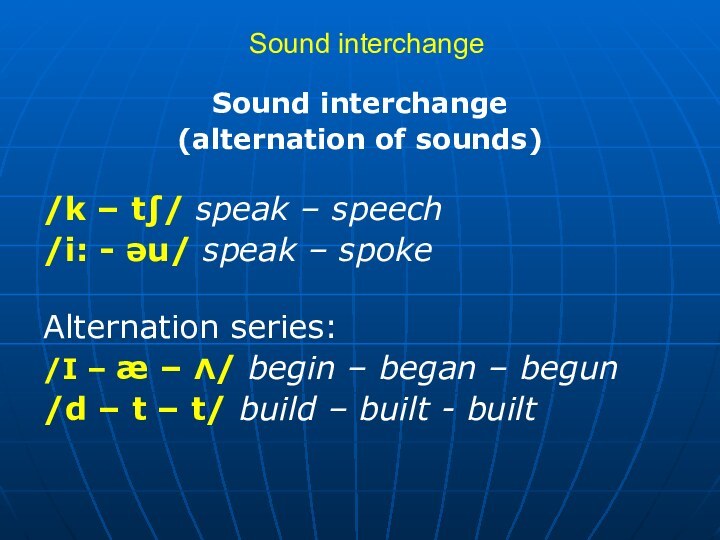
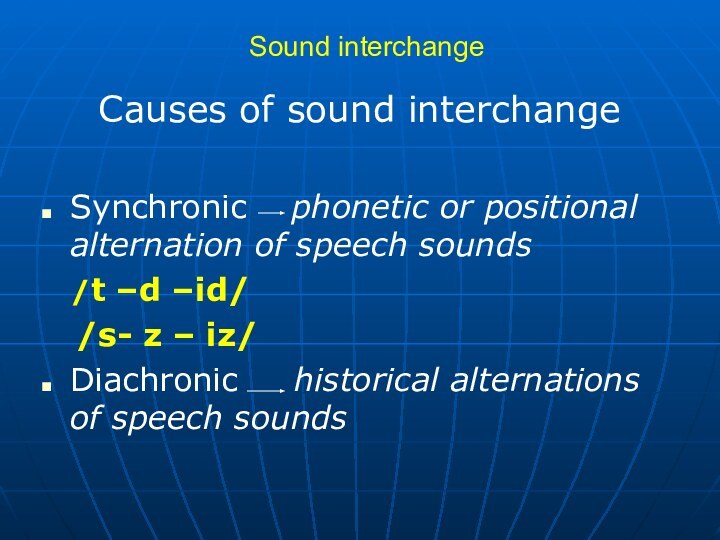
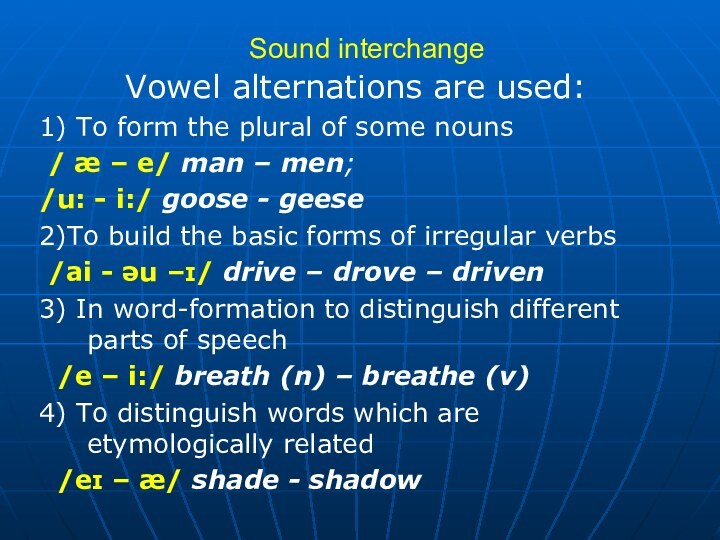
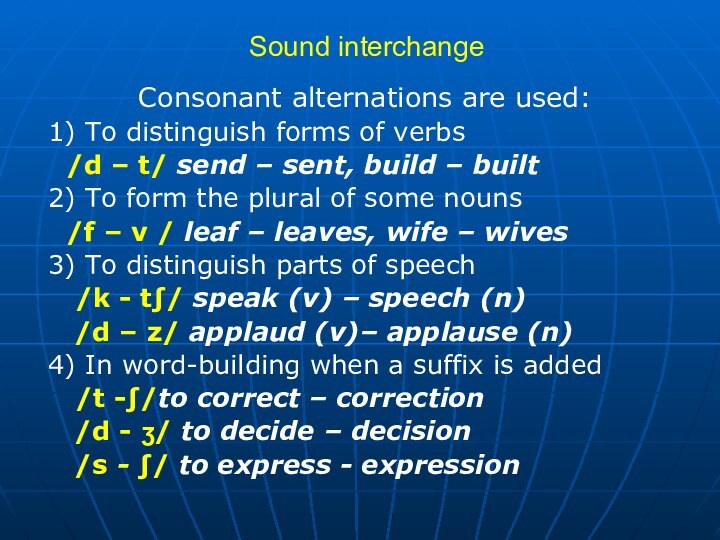
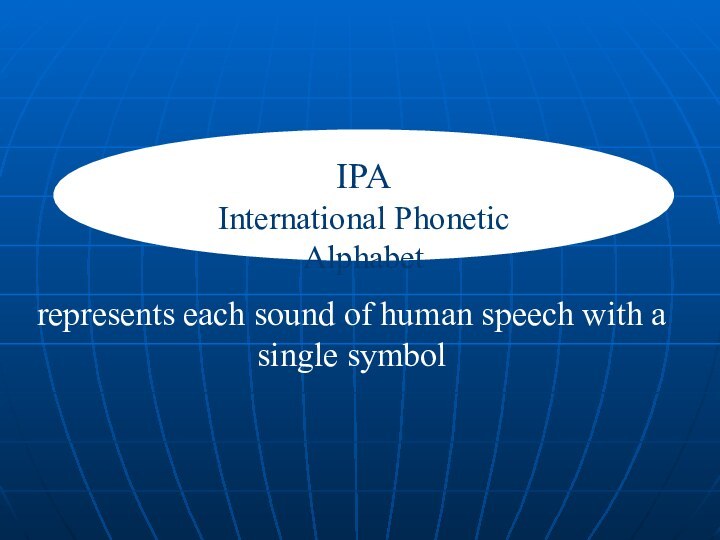

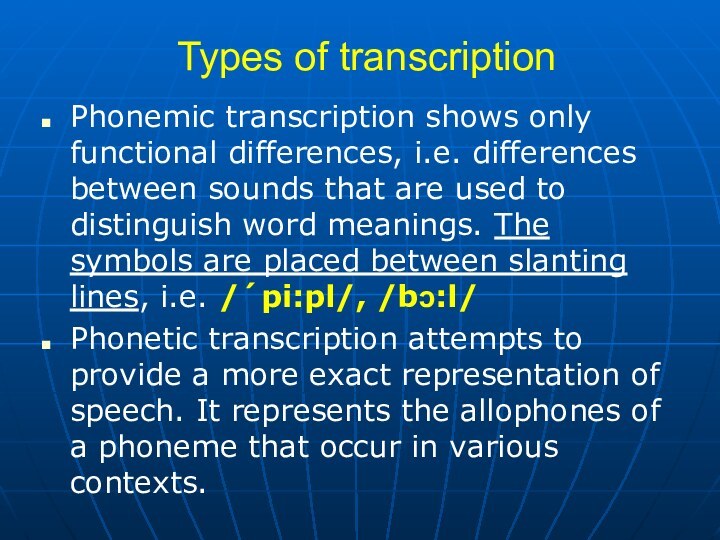

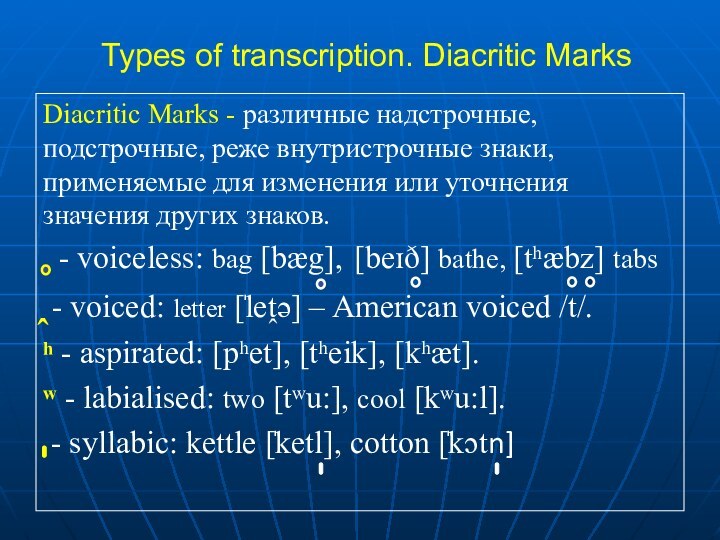
![The Phonological Analysis of English Speech Sounds Types of transcription. Diacritic Marks~ - nasalized: [tẽn], [pɒ̃nd], [mæ̃n].: - long:](/img/tmb/15/1443545/b8a527f09cc219012efec3cb2788feaf-720x.jpg)
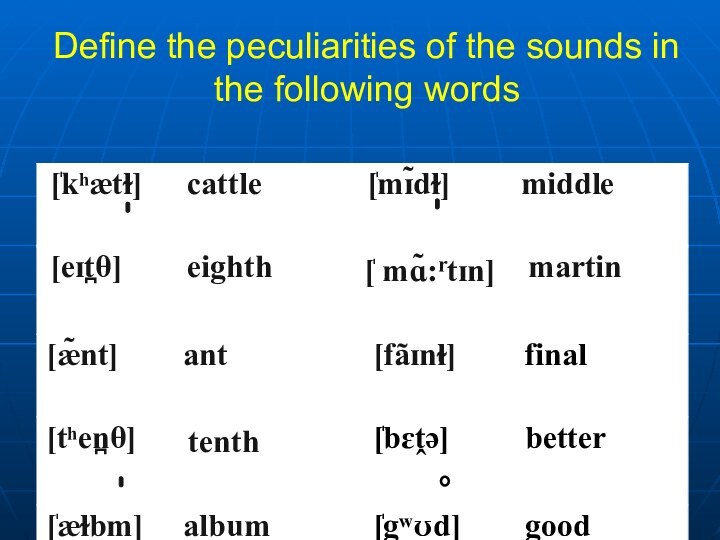
Слайд 3
The Phonological Analysis of English Speech Sounds
In connected
speech a sound is generally modified (видоизменять, трансформировать)
1)
by the neighbouring sounds; 2) by its position in a word or a phrase;
3) by prosodic features: stress, melody, the tempo of speech
Слайд 4
The phoneme, its definition, aspects and functions
/pil/ -
/spil/ - /slip/ - /´slipə/
pill – spill –
slip – slipperThe various /p/-sounds differ in the manner of articulation and the acoustic qualities. But they do not differ phonologically. If one of them is substituted for another, the meaning of the word will not change.
Слайд 5
The Phonological Analysis of English Speech Sounds
pill –
bill
/p/ /b/pill – mill
/p/ /m/
The substitution of one sound for the other will change the meaning of the word and effect communication.
Слайд 6
The phoneme, its definition, aspects and functions
That’s why
/p/ and /b/ are different elements of the English
phonetic system, they are different phonemes.And the various /p/-sounds in the words pill – spill – slip – slipper are positional variants or allophones of the phoneme /p/.
Слайд 7
The phoneme, its definition, aspects and functions
All the
actual (реально существующие) speech sounds, pronounced by the speaker
are, are positional variants or allophones of the phoneme that exist in a language.In English there are 20 vowel phonemes and 24 consonant phonemes.
In Russian there are 6 vowel and 35 consonant phonemes.
Слайд 8
The phoneme, its definition, aspects and functions
V.A. Vassilyev
The segmental phoneme is the smallest (i.e. further indivisible
into smaller consecutive segments) language unit that exists in the speech of all the members of a given language community as such speech sounds which are capable of distinguishing one word from another word of the same language or one grammatical form of a word from another grammatical form of the same word.
Слайд 9
The phoneme, its definition, aspects and functions
The aspects
of the phoneme:
material, real and objective
abstractional and generalised
functional
Слайд 10
The phoneme, its definition, aspects and functions
Aspect 1
The
phoneme has a material aspect because it exists in
speech in the material form of speech sounds – allophones.The phoneme is also a linguistic reality because it exists in real speech.
The phoneme is objective because it exists independently of the will of individual persons.
Слайд 11
The phoneme, its definition, aspects and functions
Aspect 2
The
phoneme is abstracted from its variants that exist in
actual speech and, at the same time, it is characterized by features common to all its variants (e.g.: /b/ is an occlusive, bilabial, lenis, consonant/. These features are common to all its allophones.
Слайд 12
The phoneme, its definition, aspects and functions
Aspect 3
The
phoneme has a functional aspect: it is capable of
differentiating words and their grammatical forms.
Слайд 13
The phoneme, its definition, aspects and functions
The functions
of the phoneme:
1) distinctive
word-distinctive: /´dri:mə
- ´dri:mi/form-distinctive: /α:sks - α:skt/
sentence-distinctive: It was cold.
It was gold.
Слайд 14
The phoneme, its definition, aspects and functions
The functions
of the phoneme:
2) constitutive (являющийся образующим или неотъемлемым элементом
чего-л.)The phonemes in isolation have no meaning, but they constitute morphemes and words, all of which are meaningful.
Слайд 15
The phoneme, its definition, aspects and functions
The functions
of the phoneme:
3) recognitive (identificatory)
(распознавательная)
This function of the phoneme
consists in making words with their grammatical forms easily recognizable as a result of the use of right allophones in their right places.
Слайд 16
The phoneme theory
The phoneme theory was originated in
Russia. Its founder was Prof. I.A. Bauduoin [ˈbɔ:dwin] de
Courtnay [ˈkɔ:tnɪ].
Слайд 17
The phoneme theory
Baudouin de Courtenay Ivan Alexandrovich (born
Jan Nechislav)
(1845-1929)
linguist-theorist, Slavonic scholar, worker of the
Higher School of Russia and Poland, Corresponding Member of the Petersburg Academy of Sciences
Слайд 18
The phoneme theory
Baudouin de Courtenay supported the so-called
psychological school of thought in linguistics.
A phoneme is defined
by him as a group of related (родственный) sounds of a given language which are so used in connected speech that no one of them ever occurs in the position which any other can occupy.
Слайд 19
The phoneme theory
Lev Vladimirovich Shcherba
(commonly Scherba)
(1880
–1944)
Russian linguist and lexicographer specializing in phonetics and phonology.
Слайд 20
The phoneme theory. Shcherba.
L.V. Shcherba developed Baudouin de
Courtenay’s views.
He separated phonetics from phonology and stated that
sounds also possess functional properties.In every language all speech sounds are united in a comparatively small number of sound types which are capable of distinguishing the meaning and the form of words.
Слайд 21
The phoneme theory . Shcherba
Such types are called
phonemes. The numerous speech sounds we actually utter are
phonemic variations – allophones.Shcherba’s conception is a truly materialistic theory of the phoneme.
He was the first who defined the phoneme as a real independent distinctive unit which manifests itself in the form of allophones.
Слайд 22
The phoneme theory
Daniel Jones
(1881 –1967)
a London-born
British phonetician considered by many to be the greatest
phonetician of the early 20th century. He was head of the Department of Phonestics at University College, London.
Слайд 23
The phoneme theory. Daniel Jones
Daniel Jones was
a founder of the so-called ‘physical’ view which regards
the phoneme as a ‘family’ of related sounds in which various members of the ‘family’ must be similar to one another, but no member of the ‘family ‘ may occur in the same phonetic context as the other.
Слайд 24
The phoneme theory. Daniel Jones
The physical approach
overestimates the material aspect of the phoneme as it
regards the phoneme as a group of articulatory similar sounds without any regard to its functional and abstract aspects.
Слайд 25
The phoneme theory
Ferdinand de Saussure
[sɔ:ˈsʊər], [soʊˈsʊər]
(1857 –1913)
a Swiss linguist whose ideas laid a foundation for
many significant developments in linguistics in the 20th century. Saussure is widely considered to be one of the fathers of 20th-century linguistics and of semiotics, and his ideas have had a monumental impact throughout the humanities and social sciences.
Слайд 26
The phoneme theory. Ferdinand de Saussure
Ferdinand
de Saussure expressed the similar views.
He regarded phonemes
as the sum of acoustic impressions and articulatory movements.
Слайд 27
The phoneme theory
Trubetzkoy
Nikolai Sergeyevich
(1890 - 1938)
a Russian
linguist and historian whose teachings formed a nucleus of
the Prague School of structural linguistics. He is widely considered to be the founder of morphophonology.
Слайд 28
The phoneme theory. Trubetzkoy
N. Trubetskoy expressed the opposite
approach – the so-called ‘functional’ view.
It regards the
phoneme as a minimal sound unit by which meanings can be differentiated without much regard to the actually pronounced speech sounds.
Слайд 29
N. Trubetskoy’s views
Phoneme – a unity of phonologically
relevant features.
Archi-phoneme – an abstraction which combines the distinctive
features common to two phonemes./к/ лук
/К/ (neither voiced nor voiceless)
/г/ луг
Слайд 30
The phoneme theory
Leonard Bloomfield
(1887 –1949)
an
American linguist who led the development of structural linguistics
in the United States during the 1930s and the 1940s.
Слайд 31
The phoneme theory
Edward Sapir
(1884 –1939)
a German-born
American anthropologist-linguist and a leader in American structural linguistics.
He was a highly influential figure in American linguistics, influencing several generations of linguists across several schools of the discipline.
Слайд 32
The phoneme theory. Structuralists
The American structuralists Leonard /̍lenəd/
Bloomfield, Edward Sapir /sə̍pɪə(r)/ and others expressed the similar
view.They defined the phoneme as a bunch or a bundle of distinctive features, as an ‘abstractional fiction…’.
Слайд 33
The phoneme theory
The functional view of the phoneme
can be qualified as idealistic as it regards the
phoneme as an abstract conception existing in the mind but not in reality, that is in human speech.
Слайд 34
Methods of phonological analysis
Distributional method is based on
the phonological rule that different phonemes can freely occur
in one and the same position, while allophones of one and the same phoneme occur in different positions and, therefore (поэтому, следовательно), cannot be phonologically opposed to each other.pea – bee
/p/ /b/
rope – robe
Слайд 35
Methods of phonological analysis
Semantic method is based on
the phonological rule that can distinguish words when opposed
to another phoneme or zero in an identical phonetic position.
Слайд 36
Methods of phonological analysis
/si:z/ - /si:t/
/z/ vs
(versus) /t/ phonological opposition
/si:z/ - /si:/
/z/ vs
/-/ zero opposition
Слайд 37
Methods of phonological analysis
Minimal pairs – the pairs
of words which differ only in one speech sound.
pill
– bill /pil – bil/sea – tea /si: - ti:/
rise – raise /raiz – reiz/
beat – bee /bi:t – bi:/
Слайд 38
Methods of phonological analysis
If two speech sounds distinguish
words with different meanings, they are a realization of
two different phonemes.If not, they are different allophones of one and the same phoneme.
But with the sound of a complex nature the establishment of phonological opposition is not enough to determine the phonemic status of a sound.
Слайд 39
Methods of phonological analysis
/t∫/ - /dʒ/ eat –
each, head – hedge
/t/ vs /t∫/ /d/ vs /dʒ/ /tr/ - /dr/ tie – try, die – dry
/t/ vs /tr/ /d/ vs /dr/
/ts/ - /dz/ hat – hats, buzz – buds
/t/ vs /ts/ /z/ vs /dz/
Слайд 40
Methods of phonological analysis
The rules to determine the
phonemic status of a sound of a complex nature
(by N. Trubetskoy):A phoneme is indivisible as no syllable division can occur within it.
A phoneme is produced by one articulatory effort.
The duration of a phoneme should not exceed that of other phonemes in the language.
Слайд 41
Methods of phonological analysis
These rules helped to conclude
that /ʧ/ and /ʤ/ in the words like cheese,
each, jail, hedge are monophonemic, because these sounds are produced by one articulatory effort and no syllable division occurs within the sounds /ʧ/ and /ʤ/.Opinions differ about the status of /tr/ and /dr/, but most phoneticions regard them as biphonemic clusters.
Слайд 42
Methods of phonological analysis
The phonemic status of complex
vowels:
Diphthongs monophonemic
Triphthongs
biphonemicaiə = ai + ə (fire /´faiə/)
auə = au + ə (hour /´auə/)
Слайд 43
Modifications of phonemes in speech
Variation
idiolectal
diaphonic allophonic
reduction elision accommodation assimilation
Слайд 44
Modifications of phonemes in speech
Idiolectal variation embraces the
individual peculiarities of articulating sounds. For instance, the speaker
may mumble (нечётко произносить), or lisp (say ‘thish ish’ for ‘this is’), or stutter (say a f-f-f-fine d-d-d-day)/Idiolectal variation may cause a lot of difficulties in the communication.
Слайд 45
Modifications of phonemes in speech
Diaphonic variation is caused
by concrete historical tendencies active in certain localities.
E.g.,
the diaphonic variation of the sound /æ/ ranges (колеблется) from a front open /æ/ in the southern part of England to /ɑ:/ in Northern England.
Слайд 46
Modifications of phonemes in speech
Allophonic variation is conditioned
by phonetic position and phonetic environment (the influence of
the neighbouring sounds).The main types of allophonic variations are reduction, elision, assimilation and accommodation (or adaptation).
Слайд 47
Modifications of phonemes in speech
Reduction – the weakening
of articulation and shortening of the duration of unstressed
vowelsReduction
qualitative quantitative zero
can /kən/ she /∫i/ can /kn/
Слайд 48
Modifications of phonemes in speech
In qualitative reduction the
unstressed vowel is usually reduced to /ə/.
In quantitative reduction
the unstressed vowel is shortened.In zero reduction the unstressed vowel is dropped.
Слайд 49
Modifications of phonemes in speech
Elision – the disappearance
of a sound
Elision
historical
juxtapositional(contemporary)
know /nəu/ a blind man /ə blain mæn/
palm /pα:m/ sit down /si daun/
Слайд 50
Modifications of phonemes in speech
Historical elision reflects the
process in which a sound that existed in an
earlier form of a word was omitted in its later form (e.g. cupboard).In juxtapositional elision a sound that exists in a word pronounced by itself is dropped in connected speech (especially in rapid speech).
Слайд 51
Modifications of phonemes in speech
Assimilation – the process
by which a sound is altered through the influence
of a neighbouring sound.
Слайд 52
Modifications of phonemes in speech
Assimilation may influence:
the work
of the vocal cords (voice assimilation);
the active organ of
speech;the manner of noise production (loss of plosion or incomplete plosion);
the place of articulation (in trip alveolar /t/ becomes post-alveolar).
Слайд 53
Modifications of phonemes in speech
Voice assimilation is observed
when one of the two adjacent [ə̍ʤeɪs(ə)nt] (смежный, соседний)
consonants becomes voiced under the influence of the neighbouring voiced consonant, or voiceless - under the influence of the voiced consonant. E.g.:translate [trənz ˈleɪt], I shoud pay [aɪ ʃt ˎpeɪ].
Слайд 54
Modifications of phonemes in speech
The active organ of
speech may be affected in a careless rapid speech,
e.g.:Give me /ˎgɪm mɪ/;
bad pain /̍bæb ˎpeɪn/;
queen mother /̍kwi:m ˎmʌðə/.
Слайд 55
Modifications of phonemes in speech
Assimilation
(according to direction)
progressive
regressive
double(bidirectional)
desks /desks at the desk /ət ðə/ twice /twais/
bags /bægz/ ( /t/-dental ) /dj/ > /dʒ/ education
happen /hæpm/ good bye /gub bai/ /tj/ > /t∫/ situation
give me /gim mi/ /sj/ > /∫/ issue
Слайд 56
Modifications of phonemes in speech
Accommodation (adaptation) – the
process of adapting the articulation of a vowel to
a consonant, or a consonant to a vowel.Vowels:
nasalization: [tẽn]
shortening: cease [si·s]
Consonants:
palatalization: / ∫, ʒ, t∫ ∫, dʒ/ shirt, cheese, June
labialization: Compare /t/ in tea and two
Слайд 57
Modifications of phonemes in speech
The causes of allophonic
variation:
“Economy of effort”
“The law of the stronger” (M. Grammont)
E.g. of course / əf ´kɔ:s/3. Frequency of occurrence (H. Fletcher)
Frequent consonants: /t, n, s, ð, l, d/
Слайд 58
Sound interchange
Sound interchange
(alternation of sounds)
/k – t∫/
speak – speech
/i: - əu/ speak – spoke
Alternation
series:/I – æ – Λ/ begin – began – begun
/d – t – t/ build – built - built
Слайд 59
Sound interchange
Causes of sound interchange
Synchronic phonetic or
positional alternation of speech sounds
/t –d –id/
/s- z – iz/Diachronic historical alternations of speech sounds
Слайд 60
Sound interchange
Vowel alternations are used:
1) To form the
plural of some nouns
/ æ – e/ man
– men; /u: - i:/ goose - geese
2)To build the basic forms of irregular verbs
/ai - əu –ɪ/ drive – drove – driven
3) In word-formation to distinguish different parts of speech
/e – i:/ breath (n) – breathe (v)
4) To distinguish words which are etymologically related
/eɪ – æ/ shade - shadow
Слайд 61
Sound interchange
Consonant alternations are used:
1) To distinguish forms
of verbs
/d – t/ send – sent, build
– built2) To form the plural of some nouns
/f – v / leaf – leaves, wife – wives
3) To distinguish parts of speech
/k - t∫/ speak (v) – speech (n)
/d – z/ applaud (v)– applause (n)
4) In word-building when a suffix is added
/t -∫/to correct – correction
/d - ʒ/ to decide – decision
/s - ∫/ to express - expression
Слайд 62
IPA
International Phonetic Alphabet
represents each sound of
human speech with a single symbol
Слайд 63
Types of transcription
Transcription is a visual system of
notation of the sound structure of speech.
Types of
transcriptionphonemic (broad) phonetic (narrow)
‘one symbol per phoneme’ ‘one symbol per allophone’
/´pi:pl/, /bɔ:l/ [´pʰi:pl], [bɔ:ł]
Слайд 64
Types of transcription
Phonemic transcription shows only functional differences,
i.e. differences between sounds that are used to distinguish
word meanings. The symbols are placed between slanting lines, i.e. /´pi:pl/, /bɔ:l/Phonetic transcription attempts to provide a more exact representation of speech. It represents the allophones of a phoneme that occur in various contexts.
Слайд 65
Types of transcription
Phonetic transcription provides a special symbol
for each variant of each phoneme. The symbols are
placed between square brackets, i.e. the symbol [ɛ] denote a more open variant of the English /e/-phoneme, the symbol [ł] is used for a dark variant of the /l/-phoneme.
Слайд 66
Types of transcription. Diacritic Marks
Diacritic Marks - различные
надстрочные, подстрочные, реже внутристрочные знаки, применяемые для изменения или
уточнения значения других знаков.- voiceless: bag [bæg], [beɪð] bathe, [tʰæbz] tabs
̭ - voiced: letter [̍leṱə] – American voiced /t/.
ʰ - aspirated: [pʰet], [tʰeik], [kʰæt].
ʷ - labialised: two [tʷu:], cool [kʷu:l].
- syllabic: kettle [̍ketl], cotton [̍kɔtn]
Слайд 67
Types of transcription. Diacritic Marks
~ - nasalized: [tẽn],
[pɒ̃nd], [mæ̃n].
: - long: see [si:], [bɑ:k].
˙ - half-long:
seat [si˙t].ʳ- rhotocised (i.e. r-coloured):[̍sentəʳ], [kɑʳt].
- fronted, i.e. velar is made with the back of the tongue moved forward close to the hard palate when it is followed by a front vowel as in key [ki:]
̪ - dental position of the alveolar consonants: ninth [naɪn̪̪θ], tenth [tʰen̪θ].

